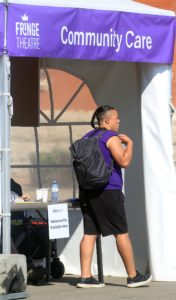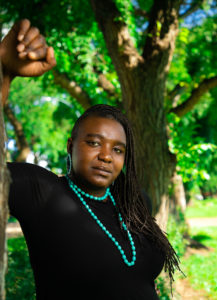Like many Edmontonians, Shima Robinson’s fringing experience began when she was young.
Her mom would bring her down to the grounds to take in outdoor shows, eat a green onion cake, and find an afternoon of fun.
“There was a thing at KidsFringe where you could put on a little costume and run around,” she recalls with a laugh. “I’ve been doing that since I was four.”
 Now, Robinson’s Fringe experience includes a different adornment: a brand-new title. As the Manager of Learning and Outreach—a new role in the Fringe organization—she’s looking to foster a sense of “radical welcome” around the Festival. Heading up the Community Care Team, Robinson helps ensure the grounds are safe and supportive for everyone: patrons, volunteers, artists, and community members alike, including those who might be displaced from the grounds during the Festival’s duration.
Now, Robinson’s Fringe experience includes a different adornment: a brand-new title. As the Manager of Learning and Outreach—a new role in the Fringe organization—she’s looking to foster a sense of “radical welcome” around the Festival. Heading up the Community Care Team, Robinson helps ensure the grounds are safe and supportive for everyone: patrons, volunteers, artists, and community members alike, including those who might be displaced from the grounds during the Festival’s duration.
“It’s super important because of the tangible, practical implications for unhoused community members,” she notes, adding the Community Care Team uses a variety of harm reduction techniques. “It’s our goal to help ensure people feel welcome, [that] there’s a level of cognizance to the effect of having a massive Festival descend on the neighbourhood for a stretch of time every summer.”

She’s also helping open Fringe up to the next generation of artists with a new program, The Build, designed by Robinson and Josh Languedoc, Fringe’s Director of Indigenous Strategic Planning. The Build offers arts- interested youth new opportunities with Fringe year-round: mentorship, programming, behind-the-scenes access, and more. Robinson and Languedoc are both artists themselves—Languedoc a playwright, Robinson a poet—and are looking to support the artistic journeys of the next generation.
Beyond Festival itself, Robinson is coordinating course offerings for Fringe Learn, a series of online workshops and educational opportunities available to staff, artists, and volunteers throughout the year— all with the goal of furthering that idea of a safe, inclusive community.
“It’s definitely gonna forward that sense of sea change in community orientation and ethos,” Robinson says. “It allows us to extend radical welcome and work on community care, and do that year round—open the space up, open the concept of what Fringe does in the community, and really build on that in a way that sets the standard.”

